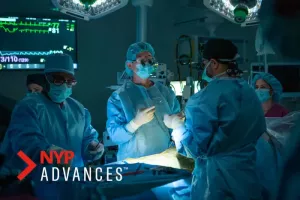Trigeminal neuralgia (TN) is a rare neurological condition that impacts the trigeminal nerve, resulting in debilitating attacks of facial pain that can occur multiple times a day. The most common form, classical TN, is caused by vascular compression of the trigeminal nerve root, and between 4 and 13 people per 100,000 are affected by the condition — although it is hard to measure incidence accurately because it can be difficult for patients to get a proper diagnosis, explains Raymond F. Sekula, Jr., M.D., neurosurgeon and director of the Facial Pain and Spasm Center at NewYork-Presbyterian and Columbia, which provides multidisciplinary care for patients with cranial nerve disorders.
Dr. Sekula is a leading expert in trigeminal neuralgia and microvascular decompression (MVD), a microsurgical technique used to treat TN by relieving the pressure on the trigeminal nerve. In 2019, he devised a scoring system to help determine which patients were the best candidates for the surgery, and recently co-authored a paper on the current state of treatment for TN. He also has forthcoming research on updates to the scoring system that help predict which patients are most likely to be pain-free long term after undergoing an MVD.
Even though MVD has been an available treatment option for TN for decades, Dr. Sekula says many patients still experience roadblocks in even getting to a surgical consultation. Below, he discusses the challenges that many of these patients face, who may be most suited for the procedure, and how the technology has advanced over the years.
What are the symptoms of classical trigeminal neuralgia, and how is it often misdiagnosed?
Individuals typically experience sharp, electrical, lancinating and paroxysmal pain, meaning there are discrete breaks in the attack. Patients describe the pain as shock-like and routinely say it’s the worst pain they’ve ever experienced. The pain is generally, but not always, restricted to one side of the face, and it strikes either the forehead, the mid cheek, or the jaw, or some combination of the three. The pain typically lasts for seconds to a minute or two. And over time it can occur hundreds of times per day.
When TN patients are continued on medication with no other options for a solution, that’s when they will often come to us as a self-referral.
— Dr. Raymond Sekula, Jr.
The pain may be mistaken for other problems like temporomandibular disorder. Patients might see a dentist and have teeth removed or get root canals, which ultimately is disfiguring or makes them worse. Sometimes patients are told that it’s an anxiety-related problem. Neurologists are often overwhelmed with the number of patients suffering with headaches, strokes, and other problems, that sometimes trigeminal neuralgia isn’t top of mind for them. Patients might also be told the only treatment is medication.
How successful are medications in treating TN?
There are two medications, carbamazepine and oxcarbazepine — there is a third in trial, for which we are one of the largest enrollees — that tend to work pretty well initially, but some patients become refractory to them. They can also have some significant side effects, both cognitively and systematically. Some patients experience drops in their white blood cell count, various metabolic issues, or often they just don’t feel well. Some have told me that at higher levels of the medications, they can’t remember their routines or balance their checkbook anymore. When these patients are continued on medication with no other options for a solution, that’s when they will often come to us as a self-referral.
How do you evaluate who might be a good candidate for MVD?
Generally, we look for three major factors. One, we ask if patients have the signs and symptoms of classical TN, meaning sharp electrical pain in attacks that are never longer than two minutes. The attacks are triggered by otherwise innocuous stimuli like light touch, cold air, chewing, smiling, and eating. Second, we see if they respond to carbamazepine or oxcarbazepine. Finally, we see if they have MRI evidence of a blood vessel deforming the nerve. This can’t be seen on regular MRI and must be detected using the latest high-resolution MRI technology. If they have these factors, then they have classical trigeminal neuralgia and are excellent candidates for MVD.
There are also secondary forms of TN that aren’t treatable using MVD. For example, about 5% of multiple sclerosis patients develop a form of trigeminal neuralgia that isn’t a vascular problem, so MVD won’t help. Other types are due to physical injury, post-herpetic neuralgia, and tumors compressing the nerve.
How effective is MVD for classical trigeminal neuralgia?
We have followed our patients carefully to determine this. We use our quantitative scoring system to assign points to certain factors that help predict how successful MVD may be for a patient.
| TN Type | Response to Carbamazepine or Oxcarbazepine | Neurovascular Contact |
|---|---|---|
| Classical - 1 | Yes - 1 | Arterial deformation - 3 |
| Nonclassical - 0 | No - 0 | Arterial contact - 2 |
| Absent Contact or Venous Contact - 1 |
Our previous research has shown that 93% of those who scored a 5 on this scale were still pain-free three years post-MVD, while that number was only 4% for those who scored a 1. Our latest research also found that 89% of those who scored a 5 remained pain-free at an average follow up of six-and-a-half years later.
So, when I’m talking to patients, we discuss these numbers to help them determine if surgery is right for them. We don’t operate on 1’s or 2’s, but if someone is a 3 out of 5, that means they have about a 50% success rate. If a patient is in agony and they’ve tried all other treatments, that might be worth it for them.
How has MVD treatment evolved over the years?
For starters, we now have highly specialized MRI technology that can detect neurovascular compression, which makes a huge difference in the care of a patient — but you also need neuroradiologists who are experienced in reading these scans; all our neuroradiologists are trained in how to interpret these.
My colleagues and I have also pioneered techniques that make MVD dramatically less invasive. This includes being able to go through an opening about the size of a nickel. We don’t use any brain retractors, and we don’t cauterize or remove any veins. We lift the blood vessel away and translocate it to another area so there's nothing touching the nerve. In most cases, patients are out of the hospital the next morning. I’ve operated on about 1,500 trigeminal neuralgia patients over my career, and all these advances have made the surgery much gentler and safer than it has ever been. The refrain we often hear is, “I wish I had done this 10 years ago. I lost 10 years of my life.”




